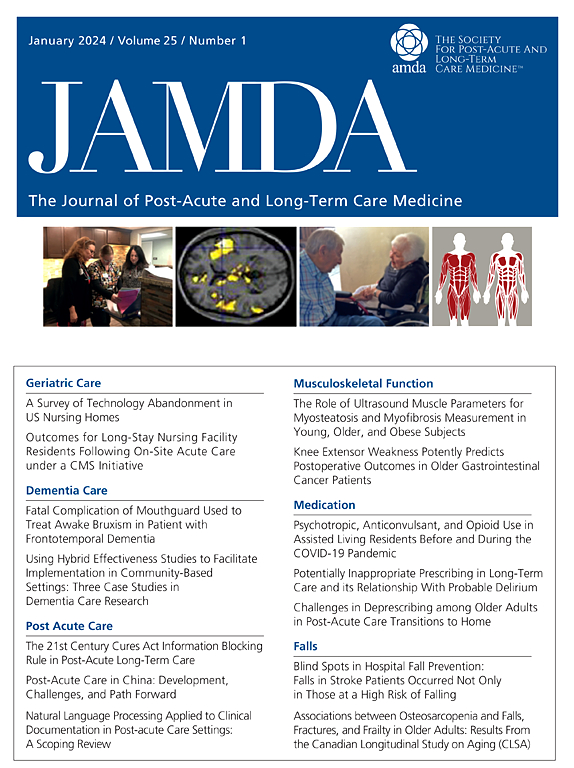基于运动的干预对老年人抑郁症状的有效性:系统回顾和网络荟萃分析
IF 4.2
2区 医学
Q2 GERIATRICS & GERONTOLOGY
Journal of the American Medical Directors Association
Pub Date : 2025-07-18
DOI:10.1016/j.jamda.2025.105583
引用次数: 0
摘要
目的:比较和排名运动干预改善老年人抑郁症状的有效性。设计:采用随机对照试验的网络荟萃分析进行系统评价。环境和参与者:老年人。方法:系统检索自建库至2024年3月16日的11个数据库,最后更新时间为2024年8月21日。随机对照试验检验了老年人运动干预的有效性。筛选、数据提取、编码和偏倚风险评估是独立进行的,一式两份。在频率学框架内进行随机效应网络元分析进行初步分析。该系统评价的方案已在PROSPERO上注册(注册号:CRD42024542830)。结果:网络荟萃分析共纳入66项研究,75个研究组和5632名参与者。与候补对照组和主动对照组相比,运动对抑郁症状有积极影响(标准化平均差[SMD] = -0.66;95% CI, -1.02 ~ -0.30;P < .001;smd = -0.66;95% CI, -0.85 ~ -0.48;P < 0.001)。两两分析表明,运动类型之间存在统计学上的显著差异:有氧运动与等候名单控制(SMD = -0.71;95% CI, -1.38至-0.04),灵活性与候补名单控制(SMD = -0.97;95% CI, -1.81至-0.14),有氧对照与主动对照(SMD = -0.70;95% CI, -1.07至-0.33),灵活性vs主动控制(SMD = -0.97;95% CI, -1.62至-0.31),神经运动vs主动对照(SMD = -0.80;95% CI, -1.25至-0.34),多组分vs主动对照(SMD = -0.56;95% CI, -0.98至-0.14)。然而,运动类型之间没有统计学上的显著差异:多组分与候补名单控制,阻力与候补名单控制,阻力与主动控制,以及5种运动类型的任意2个比较。柔韧性似乎是最有可能成为改善抑郁症状最有效的运动类型,其累积排名表面(SUCRA)值为81.7%,其次是阻力(SUCRA = 72.5%;平均排名2.7),有氧(SUCRA = 66.6%;平均秩,3.0),多成分(SUCRA = 58.2%;平均rank, 3.5)和耐药性(SUCRA = 41.6%;平均排名,4.5)。结果对发表偏倚具有稳健性;然而,有2项研究符合Cochrane的高偏倚风险标准。根据网络元分析的置信度,其置信度为极低至中等。结论和意义:以运动为基础的干预措施已被证明是治疗抑郁症状的有效方法,其中柔韧性运动训练最有可能是改善抑郁症状最有效的运动类型,其次是阻力、有氧、多组分和阻力。然而,由于较高的流失率、有限的研究数量和循环不一致,有关有效性的结论应谨慎解释。本文章由计算机程序翻译,如有差异,请以英文原文为准。
Effectiveness of Exercise-Based Interventions on Depressive Symptoms in Older Adults: A Systematic Review and Network Meta-Analysis
Objective
To compare and rank the effectiveness of exercise-based interventions for improving depressive symptoms in older adults.
Design
Systematic review with a network meta-analysis of randomized controlled trials.
Setting and Participants
Older adults.
Methods
Eleven databases were systematically searched from inception to March 16, 2024, and the search was last updated August 21, 2024. Randomized controlled trials which examined the effectiveness of exercise-based interventions for older adults were included. Screening, data extraction, coding, and risk of bias assessment were performed independently and in duplicate. Random effect network meta-analysis within a frequentist framework was conducted for the primary analyses. A protocol for this systematic review was registered in the International Prospective Register of Systematic Review (registration number CRD42024542830).
Results
A total of 65 studies with 5536 participants were included in the network meta-analysis. Compared with waitlist controls and active controls, positive effects on depression symptoms were found for exercises (standardized mean difference [SMD], −0.69; 95% CI, 0.90 to −0.48; P < .001; SMD, −0.42; 95% CI, 0.48 to −0.36; P < .001). Pairwise analysis indicated that there were statistically significant differences between exercise types: neuromotor exercise vs waitlist control (SMD, −0.82; 95% CI, 1.57 to −0.07), aerobic exercise vs active control (SMD, −0.67; 95% CI, 1.05 to −0.28), flexibility exercise vs active control (SMD, −0.76; 95% CI, 1.46 to −0.06), neuromotor exercise vs active control (SMD, −0.86; 95% CI, 1.34 to −0.38), and multicomponent exercise vs active control (SMD, −0.58; 95% CI, 1.03 to −0.14). However, there were no statistically significant differences between exercise types: flexibility exercise vs waitlist control, aerobic exercise vs waitlist control, multicomponent exercise vs waitlist control, resistance vs waitlist control, resistance vs active control, and any 2 comparisons of the 5 exercise types. Neuromotor exercise training appeared to have the highest probability of being the most effective exercise type in improving depressive symptoms with a surface under cumulative ranking (SUCRA) value of 82.7%, followed by flexibility exercise (SUCRA, 71.8%; mean rank, 2.7), aerobic exercise (SUCRA, 66.4%; mean rank, 3.0), multicomponent exercise (SUCRA, 58.5%; mean rank, 3.5), and resistance exercise (SUCRA, 42.4%; mean rank, 4.5). Results appeared robust to publication bias; however, 2 studies met the Cochrane criteria for high risk of bias. The confidence in accordance with Confidence in Network Meta-Analysis was very low to moderate.
Conclusions and Implications
Exercise-based interventions have proven to be an effective treatment for depressive symptoms, with neuromotor exercise training showing the highest likelihood of being the most effective type of exercise for improving depressive symptoms, followed by flexibility, aerobic, multicomponent, and resistance exercise. However, because of higher attrition rates, a limited number of studies, and loop inconsistency, the conclusion regarding effectiveness should be interpreted with caution.
求助全文
通过发布文献求助,成功后即可免费获取论文全文。
去求助
来源期刊
CiteScore
11.10
自引率
6.60%
发文量
472
审稿时长
44 days
期刊介绍:
JAMDA, the official journal of AMDA - The Society for Post-Acute and Long-Term Care Medicine, is a leading peer-reviewed publication that offers practical information and research geared towards healthcare professionals in the post-acute and long-term care fields. It is also a valuable resource for policy-makers, organizational leaders, educators, and advocates.
The journal provides essential information for various healthcare professionals such as medical directors, attending physicians, nurses, consultant pharmacists, geriatric psychiatrists, nurse practitioners, physician assistants, physical and occupational therapists, social workers, and others involved in providing, overseeing, and promoting quality

 求助内容:
求助内容: 应助结果提醒方式:
应助结果提醒方式:


